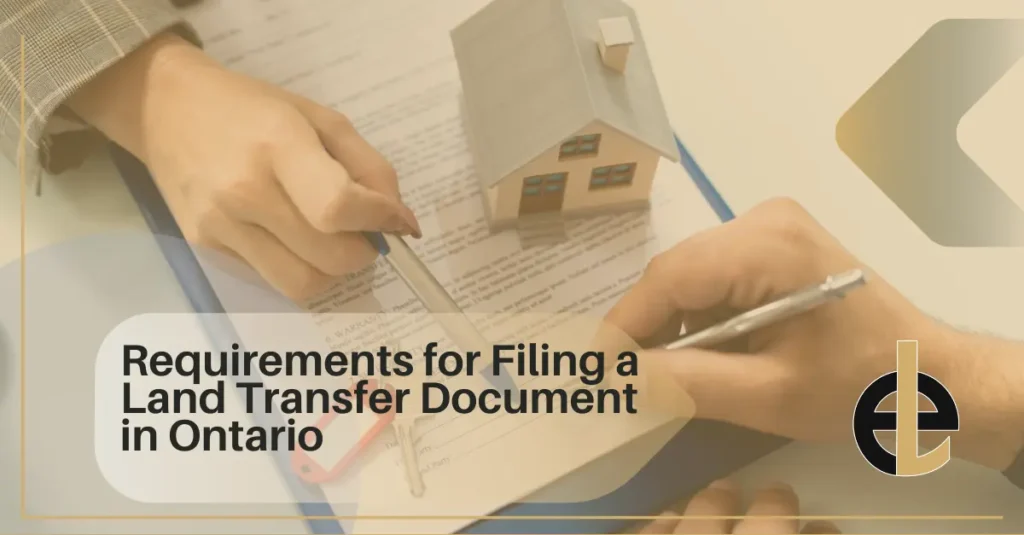Requirements for Filing a Land Transfer Document in Ontario

Transferring a property involves not just signing a contract, but filing the right documents to make the change official. A trusted Burlington law firm can guide you through the legal steps, more so when the paperwork becomes daunting. That said, knowing the key aspects of this legal process is vital, and this guide walks through the basics of filing a land transfer document to help you protect your rights.
Understanding the Need for Filing a Land Transfer Document
The land transfer document (deed) you need to file to make a transfer legal shows that the property has been passed from one person to another. Without this document, there’s no legal proof that the buyer owns the lot. There are two main types of title documents in Ontario:
1. Transfer of Title: Used in standard home purchase and sale contracts.
2. Deeds of Land: Used when property changes hands through a will or trust.
The land title transfer document includes the names of the buyer and the seller. You can also check within it the legal description of the property, details like lot number and size, along with the street address.
Let’s Simplify the Requirements for Filing a Land Transfer Document
Ensure your property transfer is legal. Get in touch with our real estate lawyer today to navigate the process and file your land transfer papers correctly.

The document also records the price paid and the date of the sale, among other key terms. Not filing this document properly is one of the causes behind common real estate disputes, especially when there is a question of lot boundaries. You can get a better grasp of these when you have a skilled lawyer’s advice and service.
Types of Land Transfer Documents to File in Ontario
You will come across one of two key documents in most real estate deals in Ontario.
Transfer of Title is used when someone is buying a home, such as a house or condo. If you purchase a townhouse, this is what you need to show to prove that you are the new owner.
Transfer Deed of Land matters when a transfer is more complex. For example, when land is passed to someone through a will, or when a parent transfers land to their child.

It is safe to say that you do not have any legal proof of ownership without a proper land transfer paper. This absence can lead to serious problems later, like when getting a mortgage. You not only protect your right by filing the title deed, but also make sure your asset is safe.
Requirements For Filing a Land Transfer Document
Filing your land transfer papers requires a few things before you actually submit them. Once you get done with these requirements, you will ensure that the process is legal and complete. As a result, you are officially seen as the owner.
Title Search
A title search checks the property’s past to make sure there are no issues. That is why it is one of the most sought-after real estate legal services. It helps confirm that the seller truly owns it and that nothing is legally wrong.
A full title search gives you much-needed peace of mind. It can uncover problems like unpaid taxes or old mortgages. Your lawyer may even find any ared rights to the land that were not present before. If you do not have it, you risk buying land that could come with problems.
Land Transfer Tax (LTT)
Most people who buy property must pay Land Transfer Tax (LTT) when they register the land transfer papers. The tax amount depends on the purchase price or fair market value.
Don’t forget to ask about rebates if you are a first-time homebuyer. If eligible, you can get a partial refund—up to $4,000 in Ontario. Some deals, such as between spouses or through certain court orders, may be exempt from LTT. Complex deals may need tax clearances from the Ministry of Finance.

In a nutshell, always calculate your total tax before you file. The Land Registry Office could reject your filing and delay the transfer if you pay the wrong amount or forget to include proof of payment.
Other Key Documents
Along with the land transfer document, you will need to gather some other papers before filing for property title transfer. These papers help confirm your ID, prove the sale terms, and meet provincial legal terms to register who owns the property.
It is crucial to know that you may be forced into correcting clerical errors if any of these are missing or filled out incorrectly. You may face delays and even legal issues. Getting it right the first time saves stress and time.
How to File Land Transfer Document Ontario
Filing a land transfer document is the final step to make your new ownership legal. You can either file online or visit a Land Registry Office in person. Many real estate brokers use the online system, but in-person help is also an option.
Step 1: Prepare Your Papers
Start by filling out the land transfer form in a precise way. Make sure all the details, like names and sale price, are correct. Attach your ID and the sale contract along with any extra paperwork. Getting a lawyer’s help is the ideal way to ensure everything is error-free.
Step 2: Pay the Land Transfer Tax
Use the property price to calculate your tax, which you can pay online or in person. Be sure to get your official receipt of payment, as this proves the tax has been paid and is needed when you file the paperwork.
Step 3: Submit Your Document
If you opt for filing a land transfer document online, upload the form and all vital files through the Teranet system. If you opt to go in person, take everything to your local Land Registry Office. They will review the forms to make sure nothing’s missing, and let you know if you need to correct anything.
Step 4: Receive Confirmation
You will receive a notice that your land transfer is complete when the registry office accepts your file. You can also request official papers through official services, such as to get a copy of a property deed Ontario for your personal or legal records. It is vital to keep a copy of this for your own use. This approval means that the proof of a new owner is now part of the public records.
Step 5: Retain All Records
Keep copies of everything, from the land transfer document to the receipt and confirmation. You may need these papers in the future for taxes or selling the property. Safe storage also helps protect your rights and show proof of ownership in case any issues emerge down the line.
Final Thoughts
Filing a land transfer document is more than just paperwork. It is what gives you legal ownership of your property in Ontario and protects your rights. It goes on record that you are the rightful owner. Thus, you stay safe from future issues with sales or legal claims.
If you are unsure about anything in the process, it’s a good idea to hire a real estate lawyer. At Estofa Law, we offer help for everything from title search to tax compliance. Let us guide you through filing everything correctly so that you save time, money, and future stress. Book a consultation with our seasoned real estate lawyer today and get started with land transfer.

